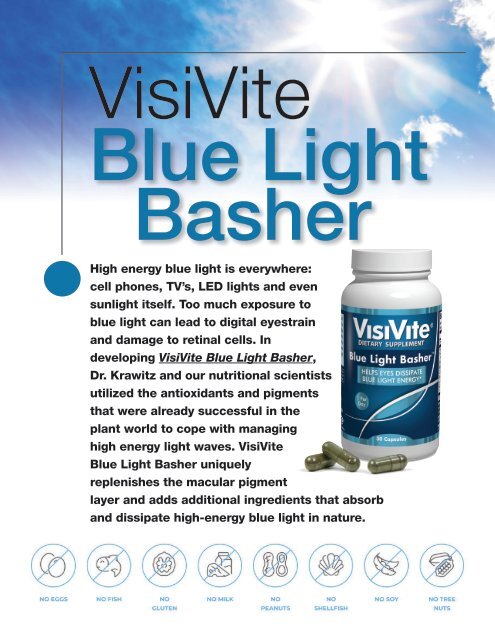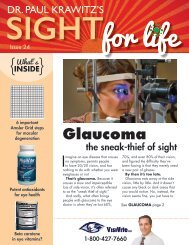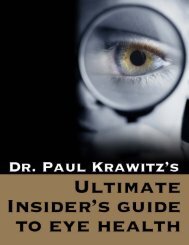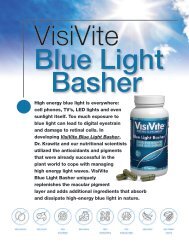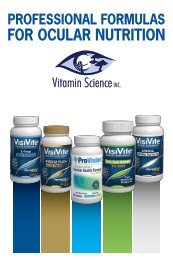Protect your Eyes from Blue Light
High energy blue light is everywhere - cell phones, TV’s, LED lights and sunlight itself. Too much exposure to blue light can lead to digital eyestrain and damage to retinal cells. VisiVite Blue Light Basher uniquely replenishes the macular pigment layer and adds additional ingredients that absorb and dissipate high energy blue light in nature.
High energy blue light is everywhere - cell phones, TV’s, LED lights and sunlight itself. Too much exposure to blue light can lead to digital eyestrain and damage to retinal cells. VisiVite Blue Light Basher uniquely replenishes the macular pigment layer and adds additional ingredients that absorb and dissipate high energy blue light in nature.
Create successful ePaper yourself
Turn your PDF publications into a flip-book with our unique Google optimized e-Paper software.
VisiVite<br />
<strong>Blue</strong> <strong>Light</strong><br />
Basher<br />
High energy blue light is everywhere:<br />
cell phones, TV’s, LED lights and even<br />
sunlight itself. Too much exposure to<br />
blue light can lead to digital eyestrain<br />
and damage to retinal cells. In<br />
developing VisiVite <strong>Blue</strong> <strong>Light</strong> Basher,<br />
Dr. Krawitz and our nutritional scientists<br />
utilized the antioxidants and pigments<br />
that were already successful in the<br />
plant world to cope with managing<br />
high energy light waves. VisiVite<br />
<strong>Blue</strong> <strong>Light</strong> Basher uniquely<br />
replenishes the macular pigment<br />
layer and adds additional ingredients that absorb<br />
and dissipate high-energy blue light in nature.
What Is <strong>Blue</strong> <strong>Light</strong>?<br />
High energy blue light is visible and directly<br />
next to ultraviolet on the light spectrum. In<br />
other words, it’s the first high-energy light in the<br />
light spectrum that we are able to see, and it’s<br />
only a few wavelengths away <strong>from</strong> ultraviolet<br />
light. <strong>Blue</strong> light has a wavelength between 400-<br />
450 nanometers, whereas UV light spans <strong>from</strong><br />
100-400 nanometers.<br />
<strong>Blue</strong> light is of concern because it has more<br />
energy per photon of light than other colors in<br />
the visible spectrum, i.e. green or red light. <strong>Blue</strong><br />
light, at high enough doses, is therefore more<br />
likely to cause damage when absorbed by various<br />
cells in our body.<br />
Where Is<br />
<strong>Blue</strong> <strong>Light</strong>?<br />
Sunlight contains blue light, but because it<br />
contains a mixture of the complete spectrum<br />
of visible colors, we don’t perceive the light as<br />
being blue.<br />
LED lights, televisions and computers, on the<br />
other hand, emit more blue light than traditional<br />
light sources. <strong>Blue</strong> light can stimulate <strong>your</strong><br />
biological circadian clock, keeping you awake,<br />
disrupting sleep, or having adverse effects on<br />
<strong>your</strong> circadian rhythm.
Does <strong>Blue</strong> <strong>Light</strong> Cause Eye Damage?<br />
There are no studies showing that<br />
blue light <strong>from</strong> electronic devices<br />
causes macular degeneration.<br />
However, there are studies in the<br />
laboratory showing that blue light can<br />
cause cellular damage, either directly<br />
to retinal cells or to the supporting<br />
retinal pigment epithelial cells directly<br />
below the retina.<br />
• A study in the professional journal,<br />
Investigative Ophthalmology and Visual<br />
Science concluded that the decay<br />
molecule, lipofuscin, accumulated<br />
in the retinal pigment epithelial layer<br />
following exposure to blue light and<br />
were indicative of cellular destruction.<br />
• Another article in IOVS concluded<br />
that blue light damage in animal eyes<br />
was a result of turnover of the molecule,<br />
rhodopsin, found in the retina.<br />
• A study in the journal Cells concluded<br />
that blue light impaired cell viability<br />
and induces cell death.<br />
Plant Pigment<br />
Wavelength Absorption<br />
How Does Nature <strong>Protect</strong> Itself Against <strong>Blue</strong> <strong>Light</strong>?<br />
Fortunately, the plant world, exposed to allday<br />
light <strong>from</strong> the sun, has already developed<br />
mechanisms for protecting itself against high<br />
energy light, including Ultraviolet A, B and C,<br />
as well as blue light. And the answer is in the<br />
antioxidant properties of its colorful pigments.<br />
These pigments not only help to absorb light<br />
and convert it to food and energy that the plant<br />
can use, but because there is in many cases<br />
an excess of light energy required for growth,<br />
the pigment also has the ability to dissipate<br />
the high energy light that can activate unstable<br />
forms of oxygen, which cause damage <strong>from</strong><br />
“oxidation.”
<strong>Blue</strong> <strong>Light</strong> Basher Ingredients Include:<br />
Lutein 10 mg and Zeaxanthin 2 mg<br />
The carotenoids lutein and zeaxanthin are plant-derived<br />
pigments. Because these carotenoids absorb visible light and<br />
are incorporated into ocular tissues, they can influence the<br />
optical characteristics of the human eye. The yellow-orange<br />
color of carotenoids has been shown to build healthy macular<br />
pigment optical density (MPOD) which then selectively<br />
absorbs the shorter wavelengths of the visible spectrum <strong>from</strong><br />
400–500 nm, with a peak absorbance of blue light at 460 nm).<br />
<strong>Blue</strong> light is thus filtered, with studies showing improvement<br />
in contrast and glare recovery. Studies have also shown that<br />
two of the major mechanisms of protection offered by lutein<br />
and zeaxanthin against age-related blue light damage are<br />
the quenching of singlet oxygen and other reactive oxygen<br />
species and the absorption of blue light.*<br />
Lycopene 2 mg<br />
Lycopene is the major carotenoid of the tomato and is<br />
a very efficient singlet oxygen quencher in the group of<br />
carotenoids. Following ingestion of lycopene or tomatoderived<br />
products rich in lycopene, photoprotective effects<br />
have been demonstrated. Lycopene has a stronger singlet<br />
oxygen-quenching capacity (antioxidant activity) than several<br />
carotenoids, including lutein.*<br />
Astaxanthin 1 mg<br />
Astaxanthin is a red-colored, xanthophyll carotenoid that<br />
occurs in trout, microalgae, yeast, and shrimp, among other<br />
sea creatures. Plants and living creatures with a red color are<br />
even more susceptible to blue light damage than those which<br />
are green. Research also suggests that some organisms<br />
secrete astaxanthin in response to intense light to prevent cell<br />
death.*<br />
Red beet root extract 50 mg<br />
Betanin is one example of a betalain, and<br />
is the main pigment found in red beet,<br />
and studies show it has high antioxidant<br />
and radical scavenging properties for<br />
protection against certain oxidative<br />
stress-related disorders. Studies suggest<br />
that betalains are more stable and<br />
less prone to oxidative damage than<br />
anthocyanidins. Betanin preferentially<br />
absorbs light in in the yellow, green,<br />
ultraviolet and blue wavelengths. (280–<br />
400nm and 500 – 550 nm).*<br />
Turmeric 40 mg<br />
Turmeric is a bright orange spice<br />
containing the active compound<br />
curcumin. Given orally, this compound has long been<br />
studied for its ability to address inflammation and the<br />
subsequent tissue damage that results in many conditions.<br />
Recent research also points to its ability to work topically<br />
in burns and as eyedrops for glaucoma. While the extent<br />
and mechanism of blue light effect are not yet completely<br />
understood, one theory is that oxidative stress <strong>from</strong> the high<br />
energy wavelength is ultimately followed by an inflammatory<br />
cascade, releasing a variety of pro-inflammatory factors,<br />
including tumor necrosis factor (TNF) and IL-1. These<br />
mechanisms may be responsible for lower cell death seen in<br />
cultured cell studies.*<br />
Chlorophyll 50 mg<br />
Chlorophyll’s absorption of blue light, and to a lesser<br />
extent red light, is what gives the leaves of many plants<br />
their green color. In addition to its important function in<br />
photosynthesis, chlorophyll also performs the critically<br />
important activity of dissipating the sun’s energy so that<br />
intense light and oxidative damage do not burn and kill the<br />
leaves. Chlorophyll is nature’s method of dissipating highenergy<br />
light energy, including Ultraviolet (UV-A 315 – 400<br />
nm, UV-B 280 – 315 nm, and UV-C 100 – 280 nm) and blue<br />
light (380 - 500 nm). Chlorophyll acts as a light quencher,<br />
which protects the plant; and its ability to avoid degradation<br />
is facilitated by carotenoids, such as lutein, zeaxanthin and<br />
astaxanthin.*<br />
Bilberry 50 mg<br />
Billberry has been studied primarily in its ability to foster<br />
healthy circulation of blood to the small vessels feeding the<br />
eye. But in animal and tissue samples, research also shows<br />
that bilberry reduces cell destruction<br />
in response to blue and other high<br />
energy light wavelengths in the retinal<br />
photoreceptor layer and underlying<br />
retinal pigment epithelial cells. Its<br />
mechanism appears to reduce the<br />
formation of reactive oxygen species,<br />
and thus act as an antioxidant.*<br />
Zinc 10 mg<br />
Zinc is involved in numerous aspects of<br />
cellular metabolism. It is required for the<br />
catalytic activity of approximatley 100<br />
enzymes, and it plays a role in immune<br />
reactivity, the formation of proteins,<br />
wound healing, DNA formation and cell<br />
division. Studies now also support zinc’s<br />
role in protecting the eyes <strong>from</strong> damage<br />
due to strong light exposure.*<br />
*https://www.visivite.com/products/visivite-blue-light-basher


